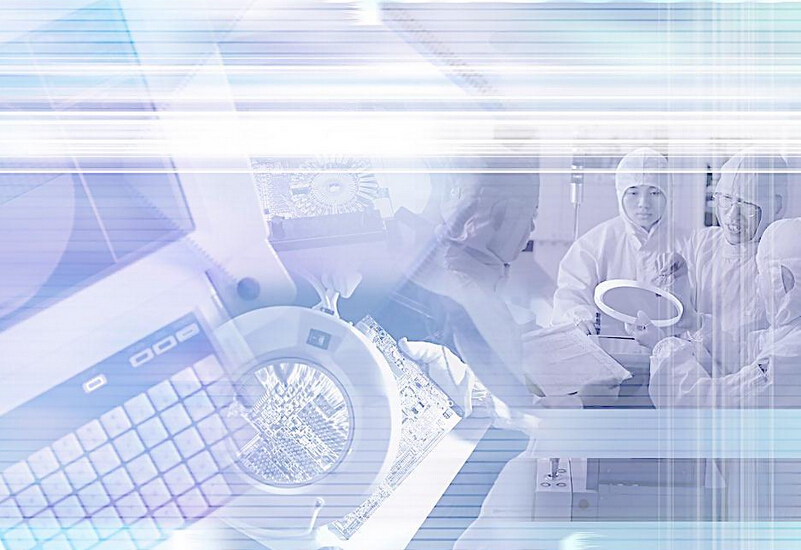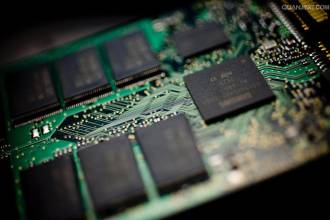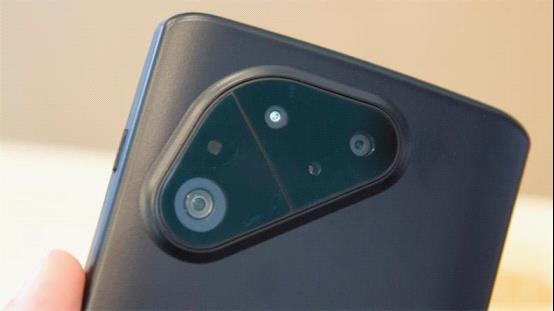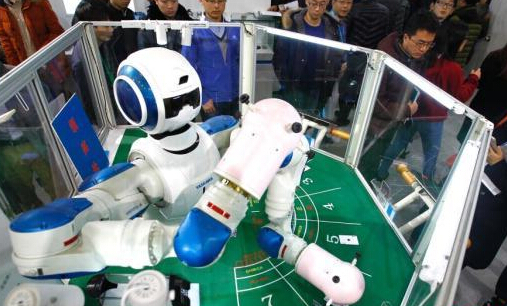Today's core news <br> According to sources, Ziguang has been re-negotiating a shareholding agreement with Micron, and Ziguang has been sincere in its sincerity: first they just want to buy a stake in Micron, not an acquisition, and Ziguang is not giving it to the US. The mainland has a DRAM factory as a negotiation condition. At the same time, Zhao Weiguo also said that he was discussing cooperation with a chip maker in the United States a few days ago, and it will be completed by the end of this month. According to industry insiders, this chip maker is very likely to be Micron.  First, the semiconductor 1, Ziguang chasing after the United States and the United States, may be married at the end of this month. The US government once said that Micron could not buy it with money, but Ziguang still did not give up its pursuit of Micron. In order to obtain the consent of the US government and Micron, the local company also began to compromise. Zhao Weiguo, chairman of Ziguang Group, said that, given the concerns of the US government, Ziguang may not be able to purchase a majority stake in the agreement. Therefore, there is no need to buy meiguang from YY Ziguang. But the good news is that the two have already sparked. According to sources, Ziguang has been re-negotiating a shareholding agreement with Micron, and Ziguang has been sincere in its sincerity: first they just want to buy a stake in Micron, not an acquisition. In addition, Ziguang has given DRAM factories in the mainland as a negotiation. condition. At the same time, Zhao Weiguo also said that he was discussing cooperation with a chip maker in the United States a few days ago, and it will be completed by the end of this month. According to industry insiders, this chip maker is very likely to be Micron.
First, the semiconductor 1, Ziguang chasing after the United States and the United States, may be married at the end of this month. The US government once said that Micron could not buy it with money, but Ziguang still did not give up its pursuit of Micron. In order to obtain the consent of the US government and Micron, the local company also began to compromise. Zhao Weiguo, chairman of Ziguang Group, said that, given the concerns of the US government, Ziguang may not be able to purchase a majority stake in the agreement. Therefore, there is no need to buy meiguang from YY Ziguang. But the good news is that the two have already sparked. According to sources, Ziguang has been re-negotiating a shareholding agreement with Micron, and Ziguang has been sincere in its sincerity: first they just want to buy a stake in Micron, not an acquisition. In addition, Ziguang has given DRAM factories in the mainland as a negotiation. condition. At the same time, Zhao Weiguo also said that he was discussing cooperation with a chip maker in the United States a few days ago, and it will be completed by the end of this month. According to industry insiders, this chip maker is very likely to be Micron.
2. IDT purchased German semiconductor ZMDI. IDT announced that it will acquire ZMDI (Zentrum Mikroelektronik Dresden AG), a private company, for $310 million in cash. Through this acquisition, IDT will expand into the automotive and industrial markets and strengthen its position in high-performance programmable power supplies and timing and signal conditioning technologies. Bringing new digital power products that meet the needs of communication infrastructure and data centers to create a smart power semiconductor industry alliance. IDT has immediate synergies in wireless charging, power management and timing and signal conditioning, as well as significant growth opportunities for the automotive and industrial industries. ZMDI's business has grown steadily, and this time IDT's scale and technology have once again developed and profited.
Second, automotive electronics 1, Volvo unmanned concept car is determined to innovate. According to the British "Daily Mail" recently reported, Volvo's new concept car at the Los Angeles Auto Show showcased the interior layout of future driverless cars, with reclining chairs and pop-up screens. This driverless car has a lot of quirky interiors, from the seat to the screen using lasers to the screen, reclining chairs and pop-up TV screens, allowing passengers to work or watch movies in times of traffic jams, on monotonous highways Enjoy a relaxing auto driving experience. Third, intelligent hardware 1, MIT invented cheap 3D scanners, the effect increased by 1000 times. Now, scientists have developed quite good 3D imaging technology, in addition to new technologies that are cheaper and cheaper. In fact, the combination of top technology and low cost seems to have always been a contradiction. It seems that there is no coexistence, but researchers from MIT have recently made new breakthroughs in this area, not only in terms of image quality, but also The cost is also very low. Specifically, this new polarization technology can increase the accuracy of any traditional inexpensive 3D imaging device by a factor of 1000, not only faster than the familiar Microsoft Kinect somatosensory device, but also more accurate than portable laser scanners. high. Advances in this technology may change the rules of the game in computer imaging, and can be applied to mobile phones and cameras, and even more accurate 3D scanning for driverless cars, even in rainy or snowy conditions. The security situation.
Third, intelligent hardware 1, MIT invented cheap 3D scanners, the effect increased by 1000 times. Now, scientists have developed quite good 3D imaging technology, in addition to new technologies that are cheaper and cheaper. In fact, the combination of top technology and low cost seems to have always been a contradiction. It seems that there is no coexistence, but researchers from MIT have recently made new breakthroughs in this area, not only in terms of image quality, but also The cost is also very low. Specifically, this new polarization technology can increase the accuracy of any traditional inexpensive 3D imaging device by a factor of 1000, not only faster than the familiar Microsoft Kinect somatosensory device, but also more accurate than portable laser scanners. high. Advances in this technology may change the rules of the game in computer imaging, and can be applied to mobile phones and cameras, and even more accurate 3D scanning for driverless cars, even in rainy or snowy conditions. The security situation.
2, SmartCane smart cane, can detect obstacles by ultrasound. It is very difficult for the visually impaired to travel on weekdays, especially in places where commuting time is long and infrastructure is weak. To solve this problem, Rohan Paul of the Indian Institute of Technology developed a so-called SmartCane smart cane to make it easier for the blind to travel. According to reports, SmartCane is a device that can be installed on ordinary walking sticks. It can use ultrasonic to detect the surrounding environment, helping users to avoid obstacles. Rohan Paul believes that ordinary folding canes have many drawbacks, such as detecting limitations of long-distance obstacles. In addition to the limited length, the ordinary folding cane does not provide any information at all, and only alerts obstacles on the ground. If the obstacle is above the knee, folding the cane is useless.
Fourth, robot 1, Japanese media: Japan's future half of the labor force will be replaced by robots. On December 3, according to Japanese media reports, the Nomura Research Institute of Japan recently released research results, saying that in the next 10 to 20 years, 49% of all Japanese workers will be replaced by artificial intelligence (AI) and robots. . Research indicates that there is a high probability that occupations such as network maintainers, construction workers and taxi drivers will be replaced. In addition, occupations such as surgeons and fashion designers who create abstract concepts and need to coordinate and persuade others are less likely to be replaced.

2. IDT purchased German semiconductor ZMDI. IDT announced that it will acquire ZMDI (Zentrum Mikroelektronik Dresden AG), a private company, for $310 million in cash. Through this acquisition, IDT will expand into the automotive and industrial markets and strengthen its position in high-performance programmable power supplies and timing and signal conditioning technologies. Bringing new digital power products that meet the needs of communication infrastructure and data centers to create a smart power semiconductor industry alliance. IDT has immediate synergies in wireless charging, power management and timing and signal conditioning, as well as significant growth opportunities for the automotive and industrial industries. ZMDI's business has grown steadily, and this time IDT's scale and technology have once again developed and profited.

Second, automotive electronics 1, Volvo unmanned concept car is determined to innovate. According to the British "Daily Mail" recently reported, Volvo's new concept car at the Los Angeles Auto Show showcased the interior layout of future driverless cars, with reclining chairs and pop-up screens. This driverless car has a lot of quirky interiors, from the seat to the screen using lasers to the screen, reclining chairs and pop-up TV screens, allowing passengers to work or watch movies in times of traffic jams, on monotonous highways Enjoy a relaxing auto driving experience.

2, SmartCane smart cane, can detect obstacles by ultrasound. It is very difficult for the visually impaired to travel on weekdays, especially in places where commuting time is long and infrastructure is weak. To solve this problem, Rohan Paul of the Indian Institute of Technology developed a so-called SmartCane smart cane to make it easier for the blind to travel. According to reports, SmartCane is a device that can be installed on ordinary walking sticks. It can use ultrasonic to detect the surrounding environment, helping users to avoid obstacles. Rohan Paul believes that ordinary folding canes have many drawbacks, such as detecting limitations of long-distance obstacles. In addition to the limited length, the ordinary folding cane does not provide any information at all, and only alerts obstacles on the ground. If the obstacle is above the knee, folding the cane is useless.

Fourth, robot 1, Japanese media: Japan's future half of the labor force will be replaced by robots. On December 3, according to Japanese media reports, the Nomura Research Institute of Japan recently released research results, saying that in the next 10 to 20 years, 49% of all Japanese workers will be replaced by artificial intelligence (AI) and robots. . Research indicates that there is a high probability that occupations such as network maintainers, construction workers and taxi drivers will be replaced. In addition, occupations such as surgeons and fashion designers who create abstract concepts and need to coordinate and persuade others are less likely to be replaced.

Limit Switch,Micro Limit Switch,High Limit Switch,Telemecanique Limit Switch
Shanghai Janetec Electric Co., Ltd. , https://www.janetecelectric.com